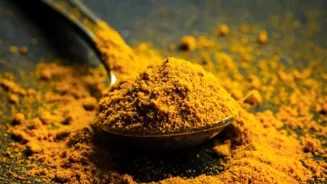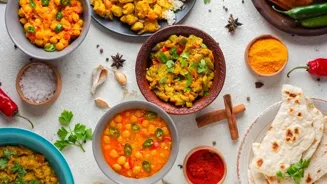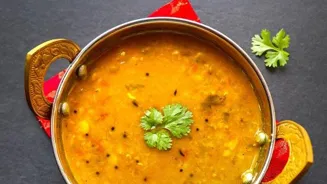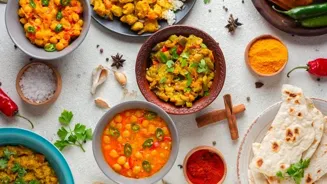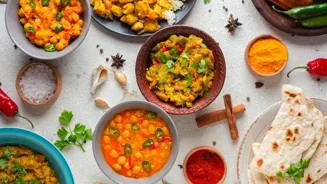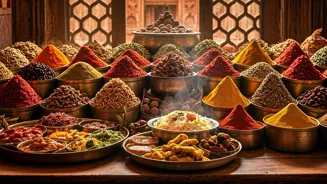Uncover the Secrets: 10 Surprising Facts About Indian Cuisine! Delve into the rich tapestry of Indian food culture. From vegetarian marvels to health benefits of spices, explore the regional diversity
and culinary innovations that make Indian cuisine truly unique. Discover more!
Namaste, food lovers! Prepare to have your taste buds tantalized and your minds blown as we delve into the captivating world of Indian cuisine. Beyond the curries and biryanis that have conquered global palates, lies a treasure trove of culinary secrets and historical nuggets.
So, grab a cup of chai, settle in, and get ready to uncover 10 fascinating facts about Indian food that you probably didn't know!
A Vegetarian Paradise: More Than Just Paneer!
While Indian cuisine is famed for its diverse range of dishes, what often gets overlooked is its strong vegetarian heritage. A significant portion of the Indian population adheres to vegetarianism, influenced by religious and philosophical beliefs such as Hinduism, Jainism, and Buddhism.
This has resulted in a remarkable evolution of vegetarian cooking, far surpassing the simple "paneer tikka masala" stereotype.
From the hearty lentil stews (dal) that form the cornerstone of many meals to the innovative vegetable preparations using spices and techniques passed down through generations, Indian vegetarian food is a testament to culinary ingenuity.
Think of the crispy dosas from South India, the flavorful vegetable curries simmered in coconut milk, or the stuffed parathas bursting with spiced potatoes or cauliflower.
Spices: Not Just for Heat, But for Health!
Indian cuisine is synonymous with spices, but their role goes far beyond simply adding heat and flavor. In Ayurveda, the ancient Indian system of medicine, spices are considered to possess potent medicinal properties.
Turmeric, for example, is renowned for its anti-inflammatory and antioxidant benefits, while ginger aids digestion and boosts immunity.
The skillful blending of spices in Indian cooking is not just about creating delicious food, it's about creating balanced and nourishing meals.
The six tastes – sweet, sour, salty, bitter, pungent, and astringent – are often incorporated into a single dish to promote overall well-being. This holistic approach to food is what truly sets Indian cuisine apart.
Regional Diversity: A Culinary Kaleidoscope
India is a land of incredible diversity, and this is reflected in its regional cuisines. Each state boasts its own unique culinary traditions, influenced by local ingredients, climate, and cultural practices.
From the creamy butter chicken of Punjab in the north to the spicy seafood curries of Kerala in the south, the flavor profiles are as diverse as the landscapes.
Even within a single region, variations abound.
A simple daal, for example, can be prepared in countless ways depending on the specific lentils used, the spices added, and the cooking methods employed. Exploring the regional cuisines of India is like embarking on a culinary adventure, with new and exciting discoveries at every turn.
The Art of Tiffin: More Than Just Lunchboxes
The "tiffin" system in India, particularly in Mumbai, is a fascinating example of culinary logistics. Every day, thousands of deliverymen (dabbawalas) transport home-cooked lunches from suburban residences to office workers in the bustling city center.

This intricate system, with its remarkable accuracy and efficiency, has become a cultural icon.
But "tiffin" also refers to the light meals and snacks that are typically eaten in India.
These can range from savory dishes like poha (flattened rice) and upma (semolina porridge) to sweet treats like ladoos (sweet balls) and barfi (fudge-like confection).
Sweets That Aren't Sinful: Natural Sweeteners and Ingredients
Indian sweets are undeniably decadent, but they often incorporate natural sweeteners and ingredients that offer some health benefits. Jaggery, a traditional unrefined sugar, is rich in minerals and is believed to aid digestion.
Honey is another common sweetener, valued for its antibacterial and antioxidant properties.
Many Indian sweets also include nuts, spices, and dried fruits, adding to their nutritional value.
Dates, almonds, pistachios, cardamom, and saffron are frequently used, providing essential vitamins, minerals, and antioxidants. While moderation is still key, you can definitely enjoy Indian sweets without feeling too guilty!
Bread Beyond Naan: Unleashing the Roti Revolution
While naan is arguably the most famous Indian bread globally, the Indian bread basket is far more diverse. Roti, also known as chapati, is an unleavened flatbread made from whole wheat flour and is a staple in many Indian households.
It's a healthier alternative to naan, as it's cooked on a griddle and doesn't require any oil.
Parathas, another popular flatbread, can be stuffed with ingredients like potatoes, cauliflower, or paneer.
Then there are dosas, thin and crispy crepes made from fermented rice and lentil batter, and idlis, soft and fluffy steamed rice cakes.
These points highlight interesting and lesser-known aspects of Indian cuisine that might not be immediately obvious to someone unfamiliar with the culture.
The focus is on diversity, health benefits, regional variations, and ingredients, while steering clear of any potentially problematic themes.

